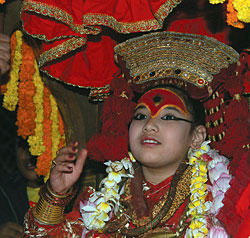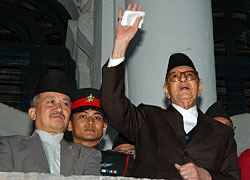|
|
Last year, anticipation was in the air as we wondered whether the king would show up or not. Of course in the end he did, and as he stood on the balcony of the Gaddi Baithak, he looked confident, arrogant, even happy, in spite of the boycott by most foreign diplomats.
This year, the same anticipation. Would this be the first time in the 250 year history of the Kumari Rath Jatra, that the festival would not be presided over by a monarch? Even till 3.30 PM no one seemed sure. In the end Girija Koirala did show up, but disappeared at the crucial time.
Inside Kumari Ghar everyone was so taken up with preparations for the 250th anniversary of Kumari Jatra, that the question of who would preside did not seem very important. "That's just politics. It doesn't concern us," one of the Kumari guardians said.
During the early and mid-eighties, we never missed the first day. To make sure we got a good vantage point, we would be sitting on the steps of the Narayan Temple (which nowadays is reserved for the massive press corps, rather unfairly keeping Kumari's biggest fans at a distance) from about 2PM, though the king would not arrive until after four and the chariot pulling would not begin until after five.
King Birendra was still an absolute monarch. While he was not popular among urban, educated youth, anything like an anti-monarchy demonstration would have been unthinkable. The monarch was simply there, and politics were forgotten at festival time.
An unforgettable feature of the festival in those days was the brutal crowd control that would begin about an hour before the king's arrival. With typical cheerful Nepali anarchy and amnesia (it happened every year) people would crowd into the square in front of the Gaddi Baithak, only to be beaten back, sometimes quite viciously, to make room for the military bands, the Newar dancers, and the king's motorcade. Even more striking was that no one actually seemed to mind. No one ever fought back, and people even smiled and laughed as they held their aching heads as if it was all part of the fun.
Not last year. Just about the time the onlookers were eventually persuaded to leave the square, a noisy crowd of Maoist anti-royalists tried to force their way in from the direction of Kasthamandap and were beaten back with the old enthusiasm. Meanwhile, in front of the king there was a small flag-waving, pro-royalist demonstration. This year it was the pro-royalist black-flag demonstration that was kept out, giving the riot police their one opportunity to wield their truncheons and make a few arrests.
 |
Also kept out, for some reason, were the dancers. Did the prime minister not wish to appear to be stepping directly into the king's footsteps? Lakhe and Bhairav had spun around enthusiastically in return for royal coins last year. Lakhe now put in an appearance just long enough to slip and fall. Bhairav and his followers literally had to fight their way into the square, then danced listlessly off to the side. Indra's elephant, a great crowd pleaser, was nowhere to be seen, at least not yet. Just before Ganesh, Bhairav and Kumari emerged, when festivities should have been reaching a fever pitch, the square went eerily quiet.
When the chariot procession started, things got very strange. The prime minister stood there smiling and waving, among far more ambassadors and far less military brass than had been present last year, as Ganesh and Bhairav stopped in front of him. Then, before Kumari's chariot approached, he went inside, followed by his ministers. At this point, an axle on Kumari's rath broke. I've seen her stuck in all sorts of potholes in the back streets, and I even remember seeing her carried home while her chariot was left to be retrieved the next day. But I have never seen her stuck before she even started.
Meanwhile the crowd was entertained by a combination of black-flag protestors fighting the police, Indra's elephant running about complaining about not being let into the square earlier, the band which kept bravely playing away, and a ten-figure tableau that got bored with standing there and started dancing.
When Kumari's rath finally got going, with nothing but a bunch of foreign ambassadors to greet her, it didn't bother to stop for the usual tribute. As soon as she had passed, Girija Babu miraculously reappeared, smiling and waving at the back of the chariot, the first time in 250 years that Kumari has not been greeted by a head of state. In fact, this must have been the strangest reception Kumari has had since Prithvi Narayan Shah appeared out of nowhere in place of Jayaprakesh Malla at the festival of 1767. Of course the upcoming tika ceremony on Sunday night is even more important, but we will have to wait and see what happens then.
 |
Once Kumari got started, she had a good long procession, not returning till 2AM. This was caused not by further breakdowns, but by the unusual number of pujas and and bhajan groups along the way in celebration of the 250th anniversary of the festival.
This was my third Kumari. Anita Shakya, Kumari in the early eighties, was always stone-faced as tradition required, in spite of the excitement around her. Rashmila Shakya, who took over from her in 1984, has told me that as soon as she donned her naga necklace, she felt like she was in a different world, and the thought of smiling, or betraying any emotion at all, never even occurred to her, though she was 'smiling inside'. The present Kumari never bothers to keep her feelings secret. She smiles and talks constantly during festivals, and I've even seen her break into tears.
Rashmila Shakya says this year's festival was different from any other she remembers. The former Kumari who is now a computer technician at Lumanti in Kopundol said that at first no one knew whether the king or the prime minister was coming. "There were no dancers in the square, so it was not as exciting as usual," Rashmila said, "and the prime minister did not throw coins, he only watched. And then when the chariot broke in front of Kumari Ghar, it was very surprising and shocking."
On the other hand, Rashmila said, everyone was very excited over the 250th anniversary of the Kumari festival, adding: "There were lots of special pujas in front of the chariot, so this year there was a very special atmosphere."
Is it reading too much into this to connect Kumari's behaviour with the present state of the monarchy? There are precedents. In 1954 Kumari mistakenly gave the king's tika to Crown Prince Mahendra, who within a year would occupy the throne.
And in 1990, Rashmila, who had always enjoyed perfect health, became ill and moody during the Democracy Movement, though she knew nothing about politics. But perhaps we should look for a more positive interpretation. Could the present Kumari's behaviour symbolise a more relaxed and open future for the nation?
Through the broken axle, the black flag demonstration and the disappearing prime minister, let's not forget that Kumari is still a symbol of the unity of the nation and of the lack of enmity between faiths: a Buddhist girl who becomes a Hindu goddess and is venerated by both communities. And if she breaks with tradition by smiling, Nepal needs all the smiles it can get these days. Let's hope hers can make a difference.
Scott Berry is associated with CNAS and, with Rashmila Shakya, is the co-author of From Goddess to Mortal, the True Life story of a Former Royal Kumari.



